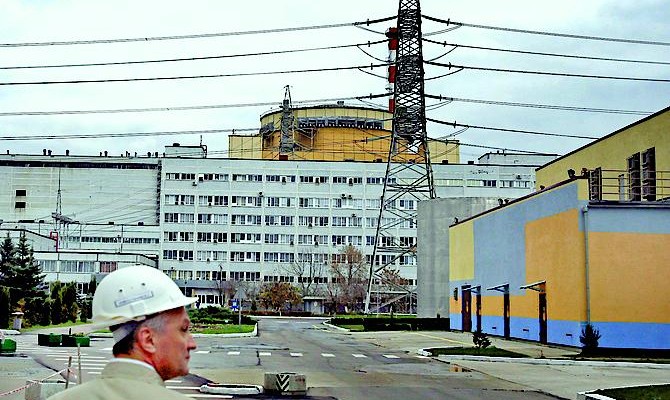Business
EnergyAnother unprofitable year for Energoatom

The Energoatom National Nuclear Energy Generating Company of Ukraine published its financial results for the period January–September 2014. The energy producer is still in the red. Over the reported period the company’s losses amounted to UAH 3.8 bn.
Watt’s the deal?
Energoatom is the largest producer of electricity in Ukraine. Over 9 months of this year it produced 47.4% of the total electricity generated in the country, the company reported. During this period, Energoatom increased its output of electricity by 4.2% compared to the January-September 2013 to nearly 64 bn kWh. Energoatom sold approximately 60 bn kWh of electricity for the total amount of UAH 19.8 bn.
Energoatom’s message in the information disclosure system of the National Securities and Stock Exchange Commission (NSSEC) says the company’s net earnings during the reported 9 months of 2014 increased significantly by 31.6% to UAH 16.55 bn. Yet, the financial affairs of the largest energy producer do not look that rosy. The Energorynok state-run enterprise, which buys electricity from all producers and performs settlements for it, paid Energoatom for only 85.4% of the supplied electricity. The amount due for the supply of electricity for the 9 months of this year amounted to UAH 2.89 bn.
Director for Information and Public Relations at the Ukrainian Nuclear Forum Association Olha Kosharna noted that the level of debt this year compared to last year increased dramatically by UAH 2.5 bn. “Electricity was sold, but the payments for it were never received,” she said. This trend is nothing new – the total debt of Energorynok to Energoatom, including arrears of previous years, amounted to UAH 6.4 bn, which is the equivalent of three months of free-of-charge operation of the company’s units.
As a result, Energoatom still shows unprofitable performance results. “All of our foreign colleagues wonder how a company that sells 83–90 billion kWh of electricity per year can be unprofitable. They cannot understand such a state of affairs,” said Kosharna.
Rising energy tariffs
At the beginning of the year Energoatom had more reasons for optimism: in April the tariff for electricity sold by the company was sizably increased by 20.5% to UAH 0.2782 per 1 kWh. Due to this, Energoatom was supposed to receive an additional UAH 2.3 bn. In May, the tariff was hiked again – by 8.7%, to UAH 0.3023 per 1 kWh. The third time, the tariff was raised by only 0.3% to UAH 0.3031 per 1 kWh. All this gave Energoatom hope that it will be able to fundamentally improve its affairs and finance all planned programs, particularly the safety improvement program for Ukrainian NPPs and the expansion program for three units.
But then devaluation of the hryvnia forced Energoatom to significantly adjust its plans. In the middle of October its president Yuriy Nedashkivskiy said that due to the devaluation of the hryvnia the company’s shortfall would exceed UAH 1 bn. “Until recently we believed that we were financially secure, but, unfortunately, we are seeing a dramatic increase in the exchange rate… such a difference is not calculated into our tariff,” he explained.
Kosharna believes the tariff hike this spring was not enough to cover the company’s losses from devaluation of the hryvnia in full. Because of the shortfall caused among other things by large debts of the energy market, Nedashkivskiy even offered to cut off power supply to those regions of Ukraine controlled by separatists, as they did not pay for the supply of electricity.
However, despite the problems of Energoatom a few days after Nedashkivskiy’s statement the National Regulatory Commission for State Energy and Public Utilities cut the tariff rate of the state-run company by almost 7% to UAH 0.2826 per 1 kWh. The cost of such a reduced tariff is approximately UAH 380 mn, which will be spent on the purchase of coal for thermal power stations.
Where is the money from?
Kosharna says in recent years Energoatom has experienced significant cash shortages due to its debts and has been forced to attract short-term loans to pay them back. In particular, Energoatom’s statements indicate that last year alone it took out five 1-year loans each in the amount of UAH 1.9 bn at the rates of 10.5– 18% per annum. Therefore, this year Energoatom has to repay UAH 4.2 bn. Next year its loan repayments may increase. In 2015 Energoatom will have to pay UAH 3.5 bn based on data published at the beginning of October. However, by the end of the year the company’s debt burden may increase – in the middle of October Energoatom announced it took out another two loans in the amount of UAH 900 mn for the term of one year.
Kosharna says it is more difficult for Energoatom to tap credits. “For this reason, the corporatization of Energoatom began in order to make it more transparent. This will help to obtain loans,” she said. At the same time, the expert noted that the main energy producer cannot deal with its financial problems independently. “There is only one way out – to cut the number of privileged consumers of electricity and reduce the amount of subsidies, which has already reached UAH 36 bn,” says Kosharna.
Meanwhile, the government demanded that the unprofitable Energoatom mobilize and speed up the process: last week Premier Arseniy Yatsenyuk said that the state-owned company should boost the construction of nuclear power plants by engaging western companies. The cost estimate for the construction of Units No. 3 and No. 4 at the Khmelnytskiy NPP drafted two years ago exceeds UAH 36 bn.




 of the agreement of syndication with Financial Times Limited are strictly prohibited. Use of materials which refers to France-Presse, Reuters, Interfax-Ukraine, Ukrainian News, UNIAN agencies is strictly prohibited. Materials marked
of the agreement of syndication with Financial Times Limited are strictly prohibited. Use of materials which refers to France-Presse, Reuters, Interfax-Ukraine, Ukrainian News, UNIAN agencies is strictly prohibited. Materials marked  are published as advertisements.
are published as advertisements.